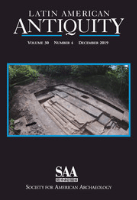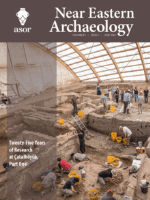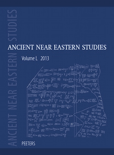
Boletin del Museo Chileno de Arte Precolombino
Scope & Guideline
Fostering Dialogue on the Tapestry of Pre-Columbian Cultures
Introduction
Aims and Scopes
- Pre-Columbian Art and Iconography:
The journal emphasizes the exploration of artistic expressions and iconography from pre-Columbian cultures, examining their meanings, contexts, and evolutions across different time periods. - Archaeological Discoveries and Methodologies:
A core focus is on archaeological findings, employing various methodologies such as material analysis, site excavations, and comparative studies to enhance understanding of ancient civilizations. - Cultural and Historical Contexts:
The journal aims to provide insights into the cultural and historical contexts of pre-Columbian societies, including social structures, rituals, and interactions among different groups. - Ethnohistory and Contemporary Relevance:
It also explores the ethnohistorical perspectives of indigenous cultures, discussing their legacies and contemporary significance in modern society. - Interdisciplinary Approaches:
By integrating perspectives from anthropology, art history, and archaeology, the journal fosters interdisciplinary research that enriches the understanding of pre-Columbian art and culture.
Trending and Emerging
- Interdisciplinary Studies of Art and Shamanism:
Recent publications increasingly focus on the intersection of art and shamanism, emphasizing how spiritual beliefs influenced artistic expression and cultural practices across various pre-Columbian societies. - Visual Culture Approaches:
There is a growing trend towards employing visual culture methodologies to analyze iconography and symbols, allowing for deeper interpretations of the social and political messages conveyed in pre-Columbian art. - Women in Pre-Columbian Societies:
Research centering on the roles and representations of women in ancient societies has gained prominence, reflecting a broader interest in gender dynamics within historical contexts. - Environmental and Material Studies:
Emerging themes include a focus on environmental factors and material studies, exploring how geography and resource availability influenced artistic production and cultural practices. - Rituals and Mythology:
A notable increase in the exploration of rituals and mythology showcases their importance in understanding the cultural identities and social structures of pre-Columbian civilizations.
Declining or Waning
- Colonial Influence on Pre-Columbian Art:
There has been a noticeable reduction in the exploration of colonial influences on pre-Columbian art, suggesting a shift away from examining how colonialism affected indigenous artistic practices. - Traditional Shamanism Studies:
Research focusing specifically on traditional shamanism within pre-Columbian cultures appears to be less frequent, indicating a potential waning interest in this theme in favor of broader cultural studies. - Material Culture of Specific Regions:
Papers concentrating on the material culture of specific regions, such as detailed studies of artifacts from singular sites, have become less common, possibly reflecting a broader shift towards more holistic regional studies. - Gender Roles in Pre-Columbian Societies:
While gender studies have been a part of the discourse, specific investigations into gender roles within pre-Columbian art and society seem to be diminishing in favor of more inclusive cultural analyses. - Static Representations of Iconography:
There is a trend away from static interpretations of iconography, moving towards more dynamic and contextualized approaches, leading to less frequent traditional iconographic analyses.
Similar Journals

LATIN AMERICAN ANTIQUITY
Pioneering Research in the Heart of Latin American HistoryLATIN AMERICAN ANTIQUITY is a prestigious journal published by Cambridge University Press, focusing on the archaeology and history of Latin America. With an impressive impact factor reflecting its critical role in the academic community, this journal exemplifies excellence in research, landing in Q1 across multiple categories, including Archaeology and History, as per the 2023 category quartiles. The journal's scope covers a broad range of topics related to pre-Columbian cultures, ancient civilizations, and historical developments, making it essential reading for researchers, professionals, and students keen on exploring the rich tapestry of Latin American heritage. Although it is not an open-access publication, LATIN AMERICAN ANTIQUITY remains a vital resource for those dedicated to advancing knowledge in this dynamic field. With its commitment to scholarly rigor and a strong ranking in Scopus, it serves as a cornerstone for academic dialogue and investigation.

NEAR EASTERN ARCHAEOLOGY
Uncovering the Past, Shaping the FutureNEAR EASTERN ARCHAEOLOGY, published by University of Chicago Press, is a premier journal dedicated to the field of archaeology, particularly focusing on the rich cultural heritage and archaeological findings of the Near East. With an ISSN of 1094-2076 and an E-ISSN of 2325-5404, this esteemed publication provides a vital platform for scholars and practitioners to share their research, insights, and discoveries. The journal holds an impressive ranking in the Q1 quartile for both Archaeology and History in 2023, reflecting its significant impact within these fields and a robust history of scholarly contribution. The journal has been pivotal in shaping discussions around archaeological methodology, theory, and contemporary issues from 2002 to 2024, as it continues to reach a wide audience through various access options. With Scopus rankings placing it in the top percentiles for both History and Archaeology, NEAR EASTERN ARCHAEOLOGY represents an essential resource for researchers, professionals, and students alike, fostering the exploration and understanding of the region's archaeological narrative.

Ancient Near Eastern Studies
Advancing Scholarship in the Heart of Ancient HistoryAncient Near Eastern Studies, published by PEETERS in Belgium, is a distinguished journal dedicated to the exploration and scholarship of the rich cultural and historical tapestry of the ancient Near East. With a focus on interdisciplinary research, this journal invites contributions across various fields including Archeology, History, Classics, Literature and Literary Theory, and Visual Arts and Performing Arts. As evidenced by its robust performance in the 2023 category quartiles, ranking Q1 in Classics and Q2 in History, this journal is recognized for its academic rigor and relevance, making it an integral platform for researchers, professionals, and students alike. Although currently not open access, it provides indispensable insights into research trends and theoretical frameworks that advance our understanding of ancient civilizations. With its ISSN 1378-4641 and E-ISSN 1783-1326, Ancient Near Eastern Studies continues to foster scholarly communication and engagement in this vital area of human history.

Eidola-International Journal of Classical Art History
Navigating the Intersection of Art and Historical Contexts.Eidola - International Journal of Classical Art History, published by Fabrizio Serra Editore, is dedicated to exploring the intricate connections between classical art and history. With an ISSN of 1824-6192 and an E-ISSN of 1826-719X, this journal stands as a pivotal resource for researchers, academics, and students within the realms of Classics, Visual Arts, and Performing Arts. Despite its recent establishment, having converged in the years 2019 to 2023, Eidola has carved out a place in various category quartiles, specifically achieving Q3 in Classics and Visual Arts and Q4 in History for 2023, indicating its growing influence in the field. Its Scopus rankings (Rank #163/170 in Classics and Rank #638/667 in Visual Arts and Performing Arts) further reflect its contribution to scholarly discourse, albeit in a competitive landscape. Though not openly accessible, the publication prioritizes substantial research, original scholarship, and critical reviews that enhance the understanding of classical art within broader historical contexts. For anyone invested in the dialogues surrounding art history, Eidola presents a vital avenue for engagement and scholarly exploration.

Ancient Asia-Journal of the Society of South Asian Archaeology
Connecting Scholars to the Wonders of Ancient AsiaAncient Asia - Journal of the Society of South Asian Archaeology, published by ARF India, stands as a pivotal resource for the exploration and dissemination of archaeological research focused on the rich history and culture of South Asia. Since its inception as an Open Access journal in 2006, it has become an essential platform for scholars and enthusiasts alike, boasting an impressive range of quartile rankings across multiple disciplines, including Anthropology, Archaeology, History, and Visual Arts. With expansion into various indexed categories and consistent dissemination of impactful research common to this highly diverse field, Ancient Asia aims to foster interdisciplinary dialogue, facilitate collaboration among researchers, and enhance the global understanding of ancient civilizations within the region. By embracing an inclusive access model, the journal encourages wide readership and engagement, positioning itself as a key player for students, professionals, and academics interested in delving into the archaeological marvels of South Asia.

Slovenska Archeologia
Connecting scholars to the treasures of Slovakia's archaeological landscape.Slovenska Archeologia is a prominent journal published by the Slovak Academy of Sciences, Institute of Archaeology, dedicated to advancing the field of archaeology through rigorous scholarly research and insightful scholarship. With an ISSN of 1335-0102 and an E-ISSN of 2585-9145, this journal has been a vital platform for archaeologists and academics since its inception, converging its insightful publications from the years 2017 to 2023. Awarded a Q2 ranking in the field of archaeology across both arts and humanities categories, it holds a respectable position in the Scopus rankings, recognizing its contributions to the discipline. Based in Slovakia, the journal is an essential resource for professionals, researchers, and students interested in archaeological findings and methodologies. While it does not currently offer Open Access options, its commitment to promoting high-quality research makes it a valuable addition to the academic community.

ARCHAEOLOGY IN OCEANIA
Delving into the Archaeological Treasures of OceaniaARCHAEOLOGY IN OCEANIA, published by Wiley, is a leading journal that delves into the rich and diverse archaeological landscape of the Pacific region. With a commitment to advancing knowledge in anthropology and archaeology, this esteemed publication has been pivotal in shaping scholarly discussions since its inception in 1966. Spanning generations of research, it has seen converged years of publication from 1966 to 1980 and from 2002 to 2024. With an impressive Scopus ranking placing it in the top quartiles across multiple categories - including Q2 in Anthropology and Q1 in Archeology (arts and humanities) - the journal distinguishes itself as a must-read for researchers, professionals, and students alike. Although it operates on a subscription model, its rigorous peer-reviewed articles and comprehensive studies contribute significantly to understanding the past of Oceania, making it an essential resource for those invested in this vibrant field of study.

OLBA
Illuminating the Rich Tapestry of Human HistoryOLBA is a distinguished journal in the field of archaeology, published by Mersin University Publications Research Center Cilician Archaeology in Turkey. With an ISSN of 1301-7667, this academic journal has been a platform for scholarly discourse from 2009 to 2014 and again from 2016 to 2019, with a recent volume published in 2022. Although it is currently categorized in the fourth quartile (Q4) for both Arts and Humanities and Social Sciences within archaeology, OLBA continues to contribute significantly to the global archaeology community. It serves as an essential resource for researchers, professionals, and students interested in the diverse aspects of archaeological studies and cultural heritage. Despite not being an open-access journal, OLBA strives to disseminate knowledge effectively, aiding in the exploration of ancient civilizations and the rich tapestry of human history. Its Scopus rankings, placing it in the bottom percentiles, demonstrate the ongoing need for the community to support and engage with the journal to enhance its visibility and impact in the archaeological domain.

Archaeologia Maritima Mediterranea-An International Journal on Underwater Archaeology
Exploring the Depths of Underwater ArchaeologyArchaeologia Maritima Mediterranea is a prestigious international journal focused on the vital field of underwater archaeology, published by FABRIZIO SERRA EDITORE. With an ISSN of 1724-6091 and E-ISSN 1825-3881, this journal has been a cornerstone for scholars and enthusiasts alike in the study of maritime cultures, shipwrecks, and submerged sites around the Mediterranean region since its inception. Operating from its base in Pisa, Italy, the journal has a commendable academic presence, reflected in its recent Scopus rankings which place it in the lower quartiles in both Arts and Humanities, and Social Sciences subcategories within archaeology. Despite its current Q4 categorization, it serves as an important platform for emerging research and advancements in the field, aiming to foster collaboration and knowledge exchange amongst researchers, practitioners, and students. While the journal is accessible through traditional subscription models, the lack of open access emphasizes the publisher's commitment to maintaining high academic standards. The collection of issues from 2011 to 2023 showcases a rich tapestry of research that contributes significantly to our understanding of underwater cultural heritage.

Deltion of the Christian Archaeological Society
Illuminating Heritage: Where Archaeology Meets FaithDeltion of the Christian Archaeological Society (ISSN: 1105-5758, E-ISSN: 2241-2190), published by the Christian Archaeological Society in Athens, Greece, stands as a pivotal source of scholarly work within the realm of Christian archaeology. This journal is dedicated to disseminating high-quality research that promotes the understanding of Christian history, heritage, and archaeological practices. Though it operates under traditional access options, it provides a comprehensive platform for researchers and professionals alike, fostering dialogue and collaboration within the archaeological community. With a commitment to advancing knowledge, the Deltion aims to support both established scholars and emerging voices, reinforcing the significance of archaeology in interpreting religious narratives and cultural contexts. Researchers, students, and professionals interested in the intersections of archaeology, history, and theology will find this journal an invaluable resource in their scholarly pursuits.